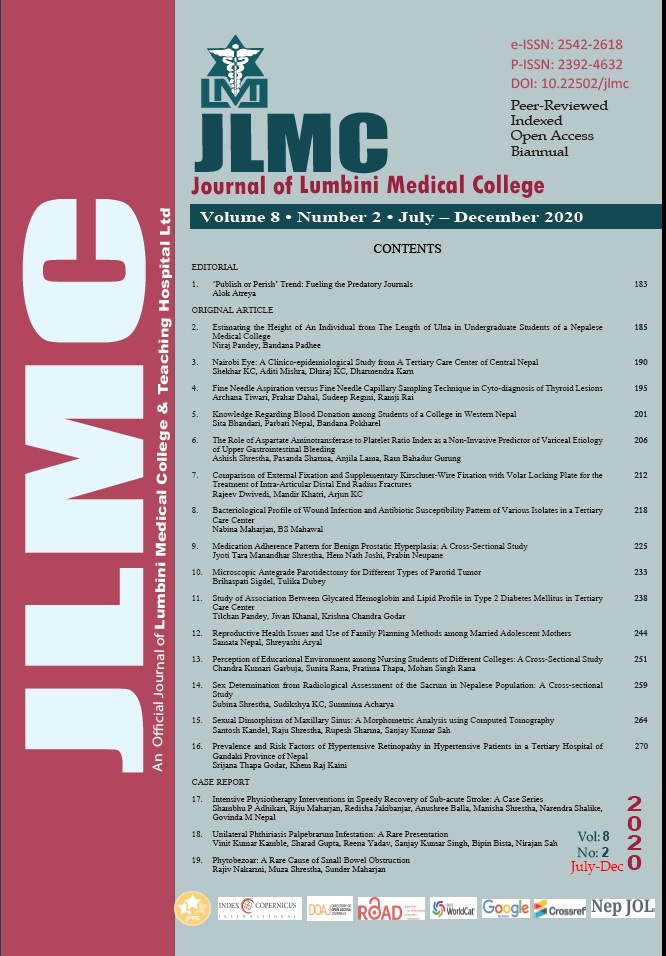Bacteriological Profile of Wound Infection and Antibiotic Susceptibility Pattern of Various Isolates in a Tertiary Care Center
Keywords:
Antibiotic susceptibility test, Extended-Spectrum Beta-LactamasesAbstract
Introduction: Wound infection due to various pathogenic microorganisms and the development of resistance to antibiotics is one of the major problems in medical sector. This study aimed to identify the etiological agents of wound infection along with their antibiotic susceptibility.
Methods: A total of 400 wound swab specimens were collected from the patients visiting a tertiary center in western Nepal over a period of six months. Thus, collected specimens were processed in Microbiology laboratory for isolation of causative agents. Antibiotic susceptibility test was performed for entire isolates by Kirby Baur disc diffusion method. Methicillin-Resistant Staphylococcus aureus was detected by cefoxitin disc diffusion test and Extended-Spectrum Beta-Lactamases producing Enterobacteriaeae by Phenotypic confirmatory disc diffusion test as recommended by Clinical and Laboratory Standards Institute.
Results: Two hundred and fifty-nine (64.7%) of specimens were infected, giving rise to 269 different isolates. Among these, 163 (60.6%) were gram positive and 104 (38.6%) were gram negative. Staphylococcus aureus (n = 130, 48.3%) was the most predominant bacteria followed by Escherichia coli (n=44, 16.3%), and Klebsiella pneumoniae (n=23, 8.5%). Gentamicin followed by co-trimoxazole was the most effective among the tested antibiotics for Staphylococcus aureus. Gentamicin and ciprofloxacin were shown effective for isolated gram-negative bacteria.
Conclusion: Fifty-eight (44.6%) of total Staphylococcus aureus were Methicillin-Resistant Staphylococcus aureus positive and 16 (20.7%) of total Enterobacteriaceae were Extended-Spectrum Beta-Lactamases producers. The increased prevalence of Methicillin-Resistant Staphylococcus aureus and Extended-Spectrum Beta-Lactamase suggest rational use of antibiotics on the basis of antibiotic sensitivity results.
Downloads
Downloads
Published
How to Cite
Issue
Section
License
Copyright (c) 2020 Nabina Maharjan, BS Mahawal

This work is licensed under a Creative Commons Attribution 4.0 International License.
The Journal of Lumbini Medical College (JLMC) publishes open access articles under the terms of the Creative Commons Attribution(CC BY) License which permits use, distribution and reproduction in any medium, provided the original work is properly cited.JLMC requires an exclusive licence allowing to publish the article in print and online.
The corresponding author should read and agree to the following statement before submission of the manuscript for publication,
License agreement
In submitting an article to Journal of Lumbini Medical College (JLMC) I certify that:
- I am authorized by my co-authors to enter into these arrangements.
- I warrant, on behalf of myself and my co-authors, that:
- the article is original, has not been formally published in any other peer-reviewed journal, is not under consideration by any other journal and does not infringe any existing copyright or any other third party rights;
- I am/we are the sole author(s) of the article and have full authority to enter into this agreement and in granting rights to JLMC are not in breach of any other obligation;
- the article contains nothing that is unlawful, libellous, or which would, if published, constitute a breach of contract or of confidence or of commitment given to secrecy;
- I/we have taken due care to ensure the integrity of the article. To my/our - and currently accepted scientific - knowledge all statements contained in it purporting to be facts are true and any formula or instruction contained in the article will not, if followed accurately, cause any injury, illness or damage to the user.
- I, and all co-authors, agree that the article, if editorially accepted for publication, shall be licensed under the Creative Commons Attribution License 4.0. If the law requires that the article be published in the public domain, I/we will notify JLMC at the time of submission, and in such cases the article shall be released under the Creative Commons 1.0 Public Domain Dedication waiver. For the avoidance of doubt it is stated that sections 1 and 2 of this license agreement shall apply and prevail regardless of whether the article is published under Creative Commons Attribution License 4.0 or the Creative Commons 1.0 Public Domain Dedication waiver.
- I, and all co-authors, agree that, if the article is editorially accepted for publication in JLMC, data included in the article shall be made available under the Creative Commons 1.0 Public Domain Dedication waiver, unless otherwise stated. For the avoidance of doubt it is stated that sections 1, 2, and 3 of this license agreement shall apply and prevail.
Please visit Creative Commons web page for details of the terms.




